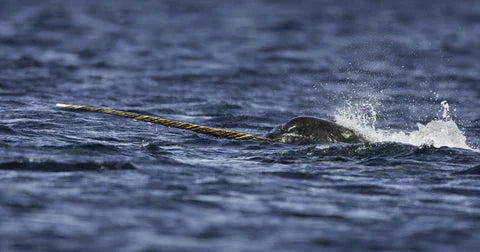Often referred to as the unicorn of the sea for most distinctive trait the creatures share- a sharp horn protruding from the top of the head- there are so many interesting facts about narwhals to learn. Even though they are very much real creatures, unlike their fantasy counterparts who live on land, much about their lives of remains a mystery. They live in the depths of the ocean in the coldest regions of the world, where only the most daring deep sea biologists brave the waters to study them. Here are some narwhal facts we have gathered for kids who love marine life and want to learn more facts about narwhals.

Strange Facts About Narwhals You Never Knew
Kids are completely fascinated by narwhals because these animals spark their wonder and curiosity in so many ways. Narwhals call the deep, icy Arctic home, which makes them incredibly difficult to study. This mystery surrounding their lives—like what they do under all that ice or how their amazing tusk truly works—really ignites a child's imagination. Kids are naturally drawn to the idea of discovering something hidden or unknown. Imagine an animal that can dive over a mile deep and hold its breath for about 25 minutes! That's a narwhal. These impressive feats make them seem like real-life aquatic superheroes. Another reason kids find them so special is that you won't see narwhals in zoos or aquariums. This fact highlights their wildness and the untouched beauty of their natural habitat, making them feel even more rare and precious. The narwhals in children's books are a far cry from the real animals that live in the depths of the ocean. Picture books paint these creatures as colorful, friendly sea creatures with a mystique similar to that of mermaids and unicorns. TFor science-minded little ones, share these facts about narwhals that will pique their curiosity and desire to learn about marine life.
Nawhal Trivia for Kids
Kids are fascinated by narwhals for some very good reasons, especially because they're like the "unicorns of the sea." Narwhals are real animals with a single, long, spiraled tusk that looks just like a unicorn's horn. This mix of reality and myth really sparks a child's imagination, making narwhals incredibly unique and intriguing. What's not to love about a "unicorn" that actually exists? Plus, narwhals live in the remote, icy Arctic waters, which makes them hard to study. This mystery surrounding their lives, especially the full purpose of their tusk, really fuels a child's curiosity. Kids are naturally drawn to things that are a bit unknown and wondrous. Continue reading to discover some incredible narwhal trivia that kids will want to know.

(1) The dagger jutting out from the head of a narwhal is similar to a front canine tooth.
The tusk is made of ivory, measures up to 10 feet long, and weighs about 22 pounds. It looks like a weapon but some scientists have a theory that it serves more as a sensory organ to survey the surrounding environment.
(2) Narwhals tend to travel in groups between 10 to 15 animals.
Groups of narwhals, called pods, can range anywhere from two to thousands that stick together. Marine scientists have discerned that the size of the pod is tied to the season. During the coldest months, smaller groups form to navigate the sea ice that forms when temperatures drop. Once the climate warms up and the ice melts, these smaller groups band together in enormous packs that enjoy swimming through the open water together.
(3) Narwhals do not have teeth.
Just like dolphins, narwhals use echolocation (the reflection of sound off an object) to identify the location of food. Once they have identified their favorite fish, which include halibut, polar cod, squid, crab, and shrimp, they sometimes use their tusks to hit their prey. This tactic stuns the fish, giving narwhals time to suck them into their mouths with great force. They swallow the fish whole due to the absence of teeth. Narwhals intake greater quantities of food during the winter months, diving as deep as almost 4,000 feet to find their prey.

(4) A narwhal's age can be determined by its color.
Babies are a blue-gray color, juveniles turn blue-black, mature adults are like a mottled gray, and senior narwhals are completely white. Even more interesting than the color schemata is the life expectancy of these sea mammals. Scientists have determined the average lifespan to be between 30 and 40 years, however, evidence points to some living to be almost 100 years of age.
(5) About every three years, female narwhals give birth to a new calf.
Narwhals mate underwater belly-to-belly, during the period of March to May, once they reach a certain age of maturity. For females, they are ready to breed when they reach 4 to 7 years while males are typically 8 to 9 years old. Pregnancy lasts about fourteen months and babies are always born in the spring. Mothers produce milk for their babies who need this nourishment for the first twenty months of their lives.
(6) Narwhals live in the Arctic Ocean.
There's a good reason why so little is known or understood about narwhals. Only very rare sightings have been reported because they live far north in the in parts of the ocean that are difficult to access. Paul Nicklen, a National Geographic photographer who grew up in an arctic region, spent ten years before ultimately finding these mysterious whales.

(7) Adults narwhals weigh more than 2,000 pounds.
The typical weight range is anywhere from 1,800 to 3,500 pounds. Males tipping the scales toward the upper range, usually in excess of 3,000 pounds while females are at least 500 pounds lighter. When babies are born, they weigh an incredible 176 pounds. In terms of length, males measure more than 15 feet long while females are closer to 13 feet.
(8) There are approximately 120,000 living narwhals.
Estimates vary across different organizations, with most numbers falling with a range of 85,000 to 125,000. They are not considered an endangered species and are not flagged for possible extinction. Approximately 1,000 narwhals are killed by throughout Canada and Greenland each year for their meat and tusks. Other factors that pose a threat include climate change, entrapment in ice, and a fishing industry that reduces food supply.
(9) The scientific name for a narwhal is Monodon monoceros.
This is the latin term for "one tooth, one horn." Narwhals are born with two canine teeth, but one of them eventually becomes a horn in males. In terms of where there more common name originates, historians trace it to Iceland where the word "nar" means corpse, and the word "hvalr" signifies whale. Legend has it that sailors thought the mottled skin looked like dead sailors floating in the water- hence the meaning "dead whale."
(10) Narwhal have extreme physical reactions to stress.
Scientists have noted that a narwhal's reaction to stress is the most extreme in all of the animal kingdom. When faced with a perceived threat, they thrash around violently in an effort to escape. Their heart rate drops to dangerously low levels, almost to the point of stopping completely. They also exhibit a simultaneous flee and freeze behavior in the wake of danger, quickly depleting their energy and oxygen levels.







